Emma Hayes has enjoyed a growing reputation within the broader game over the past 12 months, and rightfully so.
Since taking over as Chelsea manager in 2012, she has won four league titles (with the last two coming back-to-back in 2019/20 and 2020/21), two FA Cups, two League Cups, and a Community Shield.
Last season, she brought Chelsea to within 90 minutes of the peak of European competition as they played in the Champions League final against Barcelona Femeni. Still, they came up short on the day.
Nevertheless, Hayes’ Chelsea’s positive, vertical passing football—which leads to quick attacks—combined with their intelligent pressing and defensive organisation (as well as a recruitment process that has brought in elite talents like Sam Kerr, Pernille Harder, and Ji-So Yun, to name a few) has left the Blues in the enviable position of being England’s premier side in women’s football.
This tactical analysis will
provide insight into just a few of Hayes’ tactical trademarks and analyze some of Chelsea’s tactics atdifferent moments of the game.
Emma Hayes Formations and personnel
Hayes prefers to use a 4-4-2 but isn’t tied to this formation.
She experiments with variations of a midfield diamond or some form of a 4-3-3, with a 4-2-3-1 being her most preferred.
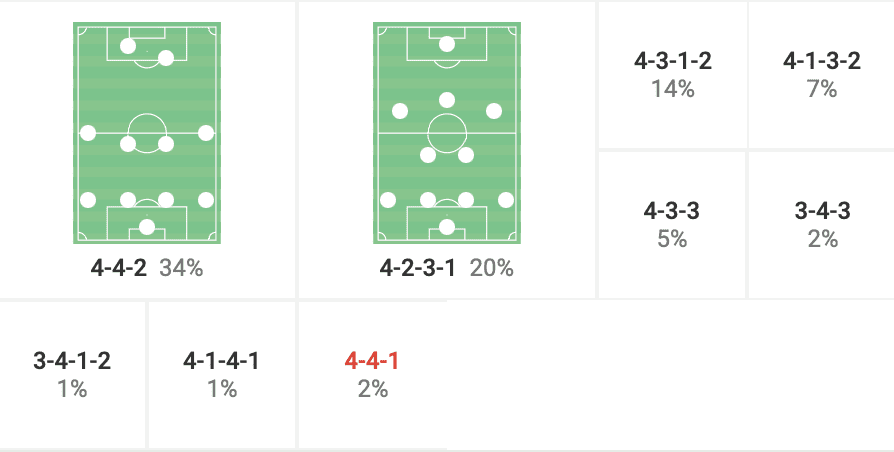
She varies her playing personnel with some degree of regularity, although some key players are seen throughout her side almost regardless of shape.
Sam Kerr, Pernille Harder, and Fran Kirby are three key attackers who will often comprise the front three, although if pushed into a 4-4-2, Kirby may well drop out to the wing.
Ji-So Yun, Sophie Ingle and Melanie Leupolz also feature heavily in the midfield, with Guro Reiten or Erin Cuthbert often used on the wing, or Niamh Charles too, who can also appear at full-back with some frequency.
In defence, Millie Bright and Magdalena Eriksson are mainstays at centre-back, whilst Jonna Andersson is often seen at left-back.
A fit Maren Mjelde is generally seen at right-back, whilst Jessica Carter competes for this spot, too.
This analysis will focus less on the shape of Hayes’ side, and more on the concepts she looks to achieve.
Emma Hayes Transition
Chelsea’s reaction to lost possession is impressively sharp.
When playing out, Hayes backs her defenders to be bold in possession and seek to break lines.
This will naturally lead to some turnovers in possession.
Firstly, the defenders who are on the goal side of the ball immediately look to get compact, with the central defender taking a side-on position ready to cover space but also delaying the forward pass with this positioning.
This gives time for the recovery runs of Chelsea’s midfielders, which are exceptional in their own right.
Chelsea’s central midfielders react quickly to drop deep and immediately press the ball carrier, delaying the forward run and posing a legitimate threat of winning the ball back consistently.
Their anticipation of the loss of possession allows them to steal ground quickly, but in general, Hayes uses quick players who are defensively strong in recoveries and ground duels.
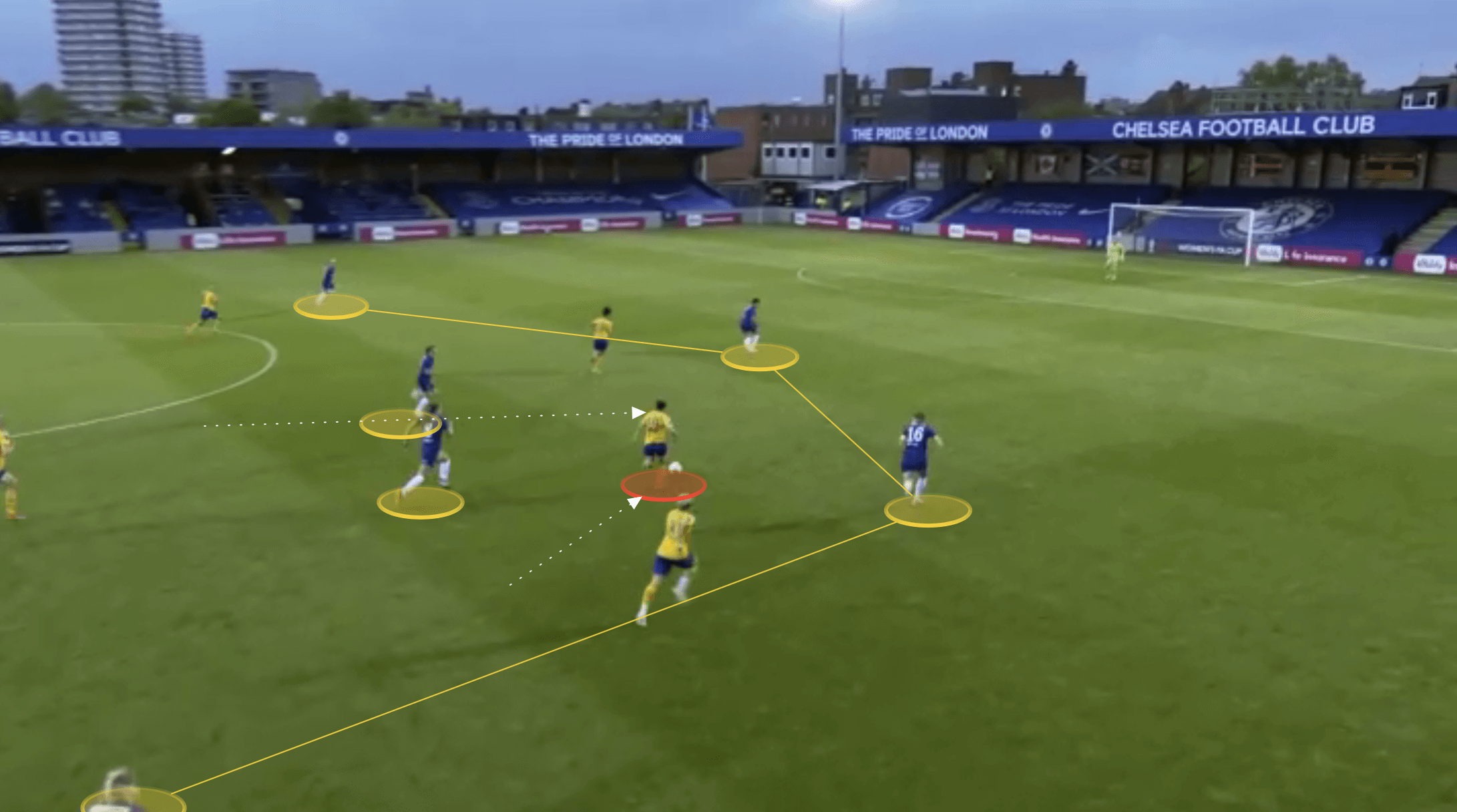
However, this section will focus predominantly on attacking transition, for Chelsea is particularly strong in this area.
Under Hayes’s tactics, Chelsea is a ruthless side on attacking transition.
Both Sam Kerr and Fran Kirby are outstanding talents who have pace and directness on the quick break.
They possess intelligent movement on top of their pace, and against teams that don’t have the pace to cover the space in behind or who don’t adjust quickly by dropping to take that space away from these players, Kirby and Kerr, in particular, can cause all kinds of problems.
It isn’t just the two aforementioned players that can cause issues alone.
If Chelsea is defending inside its own half, Pernille Harder drops deep in the defensive phase and operates in the midfield line.
Harder will react quickly to a turnover of possession, pushing forward from a wide starting berth in the following image, but importantly, moving narrow with her movement.
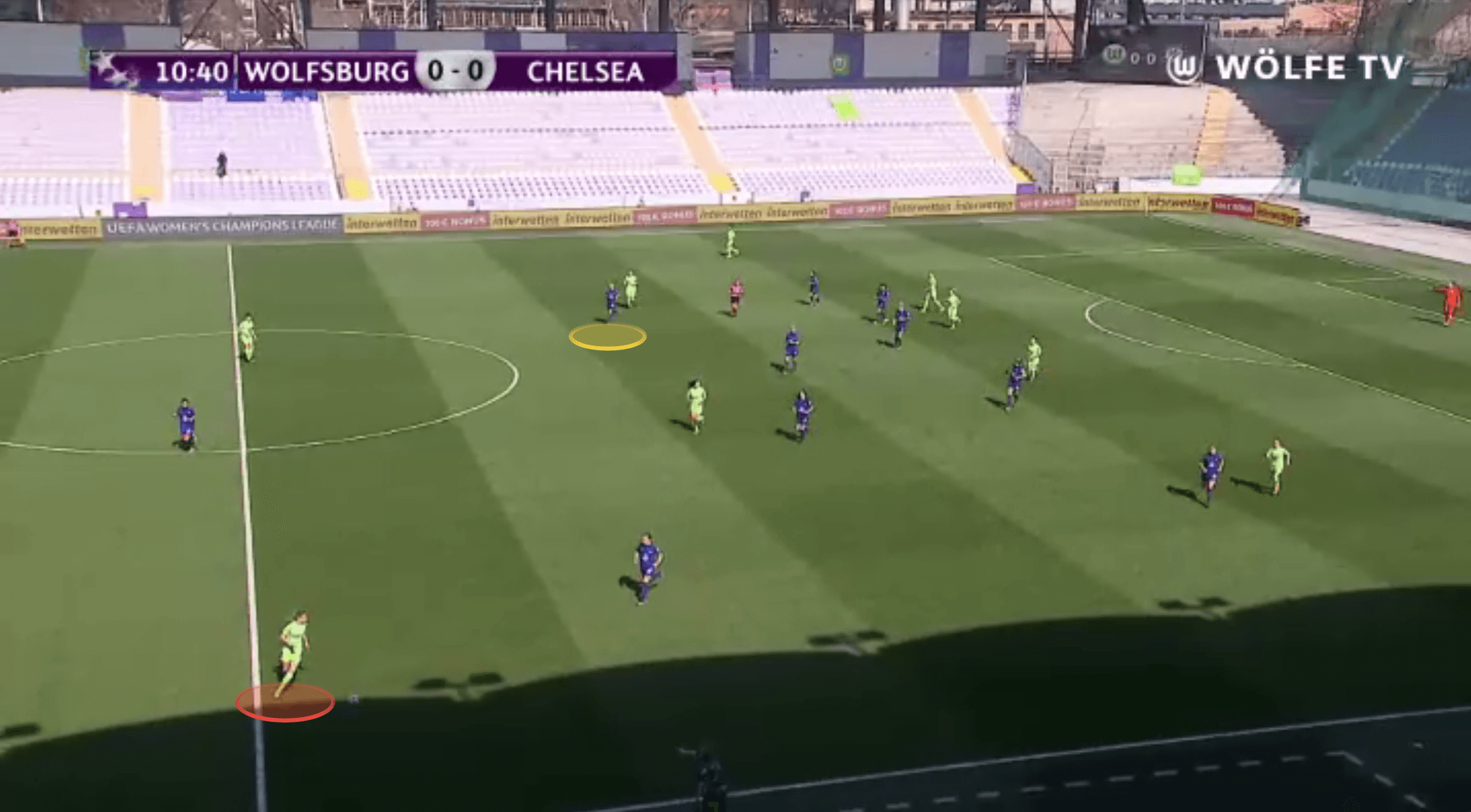
With Kerr leading the line and often providing enough of an issue for both centre-backs to be concerned with, Harder’s movement forward and inside will naturally draw an opposition full-back over.
At this stage, Harder has created the space outside the backline for Kirby to sprint forward into.
If playing against any side where the opposition winger isn’t quick to cover and drop back to protect their full-back, Kirby can have a free run of their space.
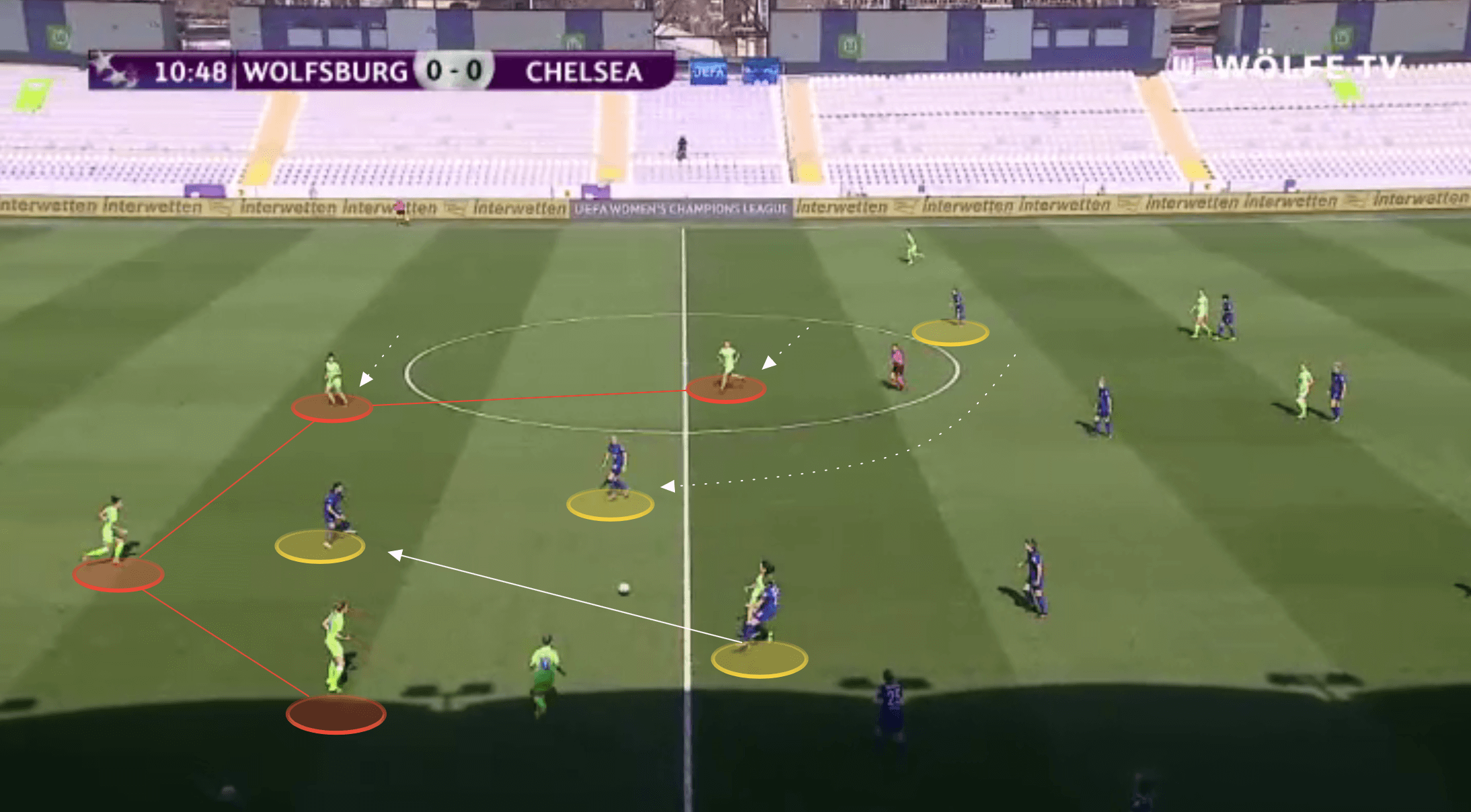
A quick combination between the central attackers only further narrows the defence and leaves the space open for the diagonal through pass to be played in behind for Kirby to run onto.
We can see this pattern coming to its completion in the following image.
Even with a player tracking back in an attempt to cover Kirby, the English attacker is so quick.
With her anticipation of this opportunity opening up for her, she naturally has the upper hand on any effort to track her run.
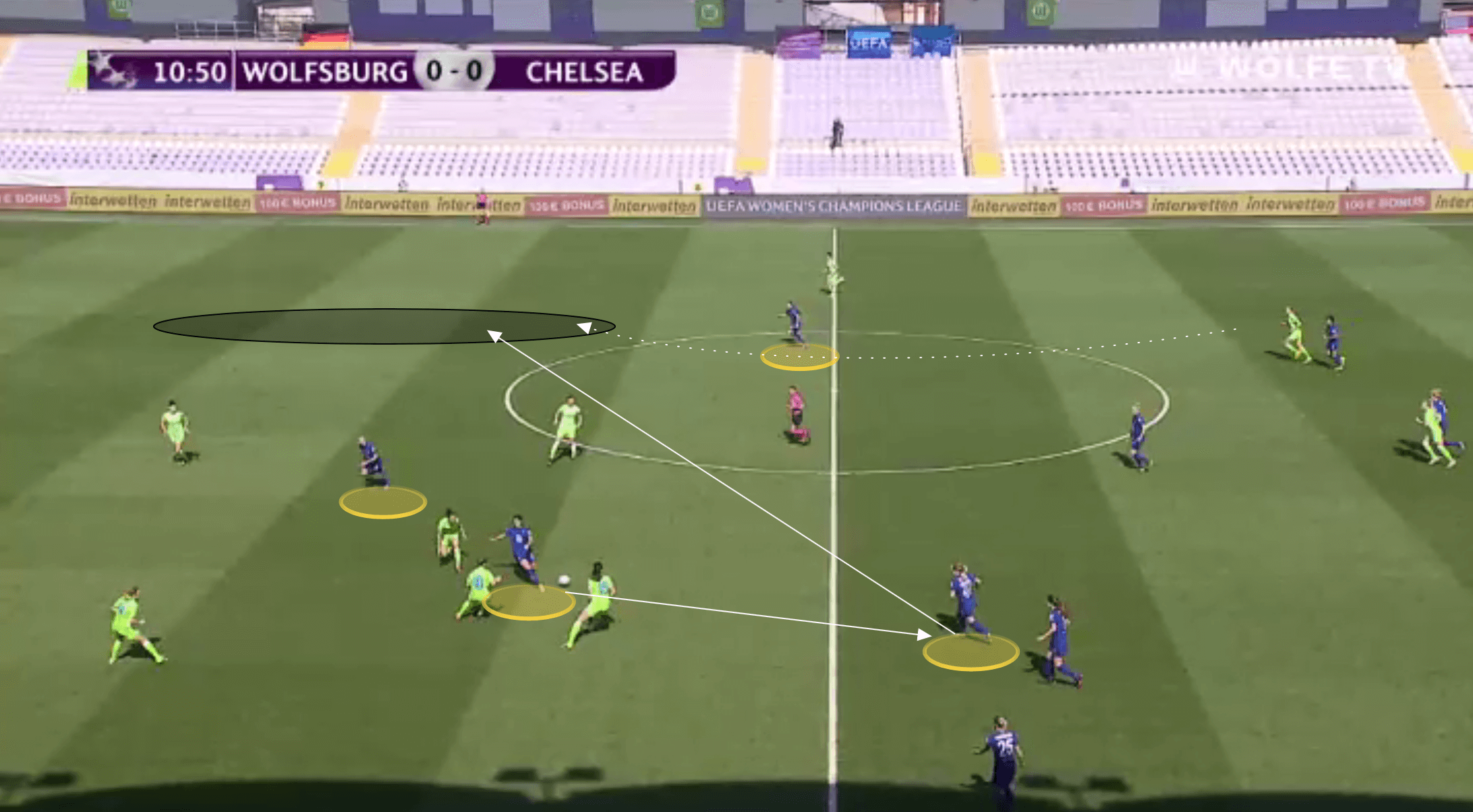
Kerr is realistically the main threat on a counter-attack, and Chelsea’s midfielders have been well-drilled to immediately look for a through pass or ball over the top when they win possession.
If teams operate with a high line, less quality is needed on the pass.
Often, a simple ball played over the top will suffice.
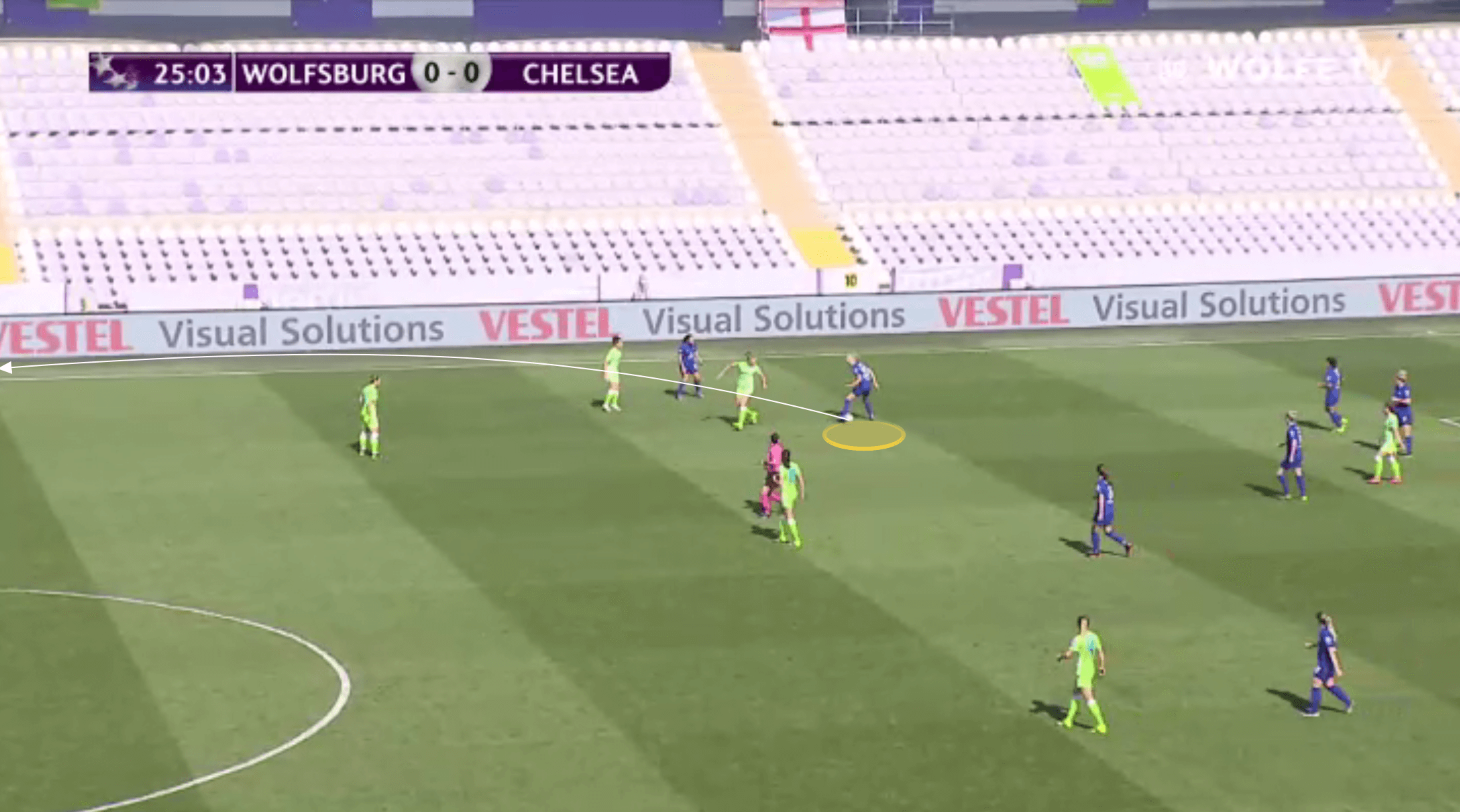
Kerr is immediately alerted to the opportunity to receive in this space.
If she decides not to drop back and stay close to the midfield, she will still not initially start on the shoulder.
Kerr gives herself several yards between her and the centre-backs, where she can’t be held if the ball is turned over.
She will look to time her run, where she is already at full acceleration as she hits the last line of the defence.
In any foot race, the Australian forward is always going to come out on top, and while critics may argue this isn’t the most revolutionary tactic, it is nevertheless highly effective.
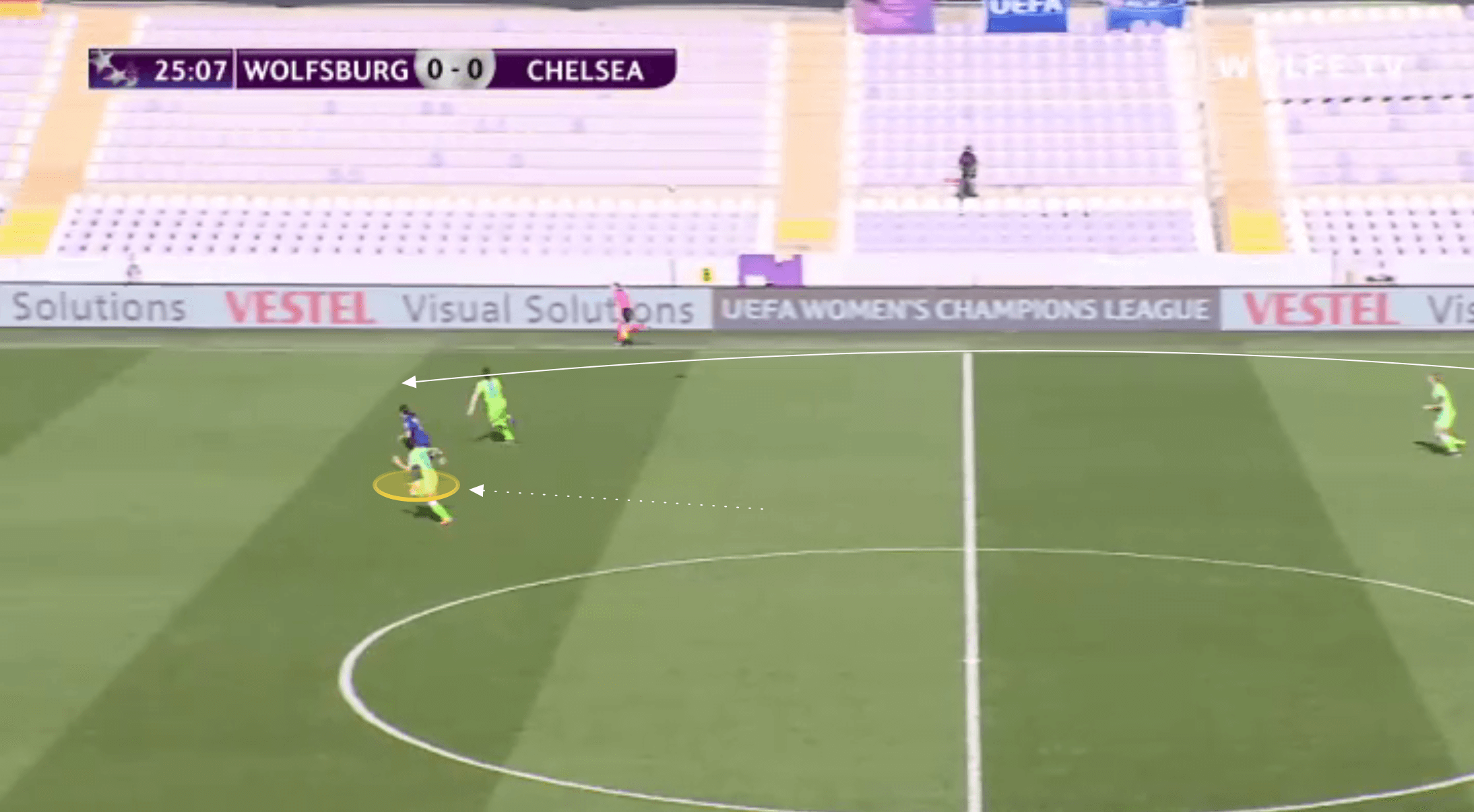
Even when defences are set slightly lower, Kerr can still manoeuvre to create enough space for the direct, immediate pass on attacking transition.
This time, the midfield needs to be more particular about pass selection, weight of pass, and accuracy.
Again, as we can see in the following image, the midfielders are positioned where they can quickly gain possession of the second ball.
As they get on the ball, they instantly look to open up on the half-turn, and they can play forward to Kerr in two touches.
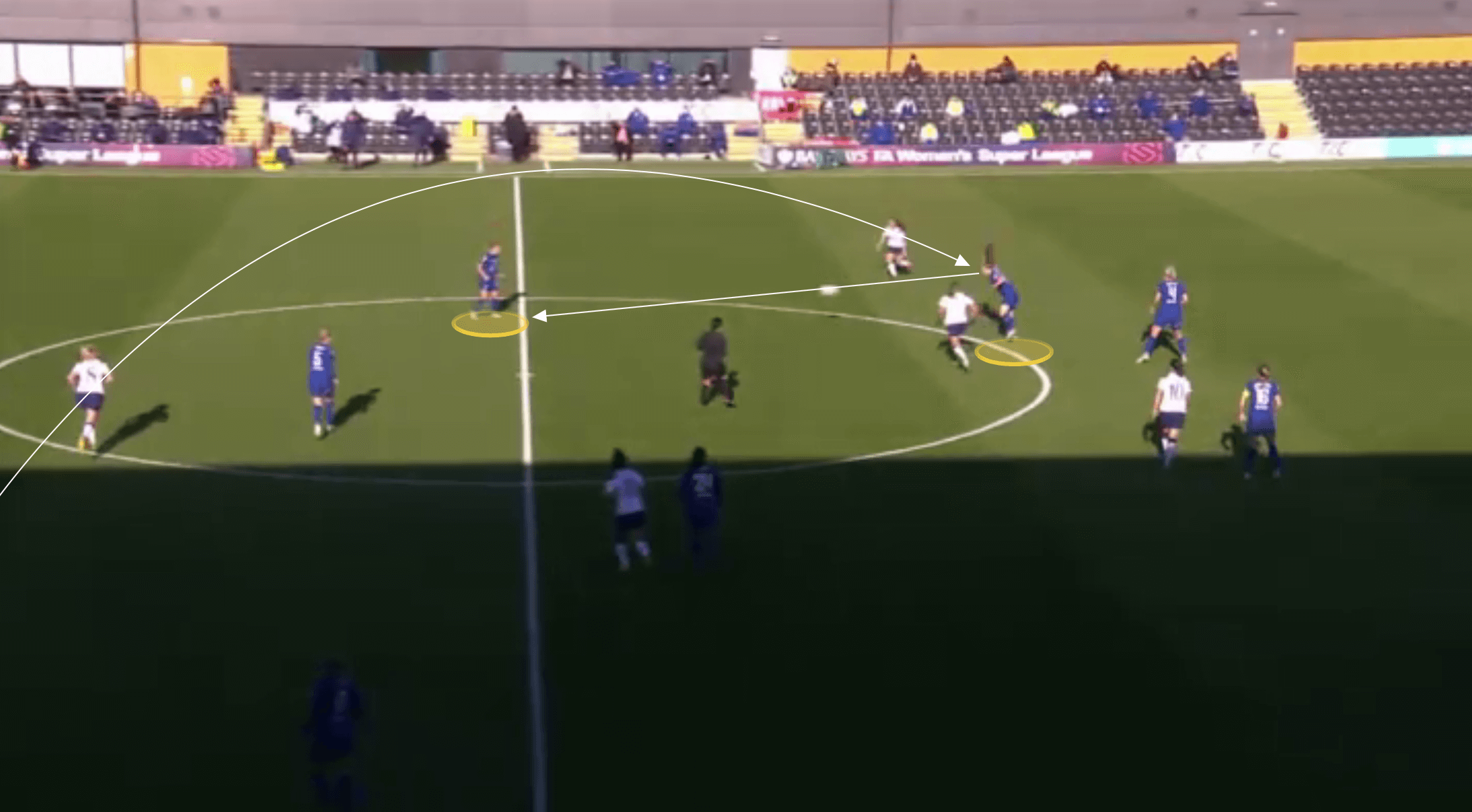
Kerr can still time her run despite a deeper starting position for the defence.
She is quick and strong enough to get to the ball before the defenders and hold off the pressure.
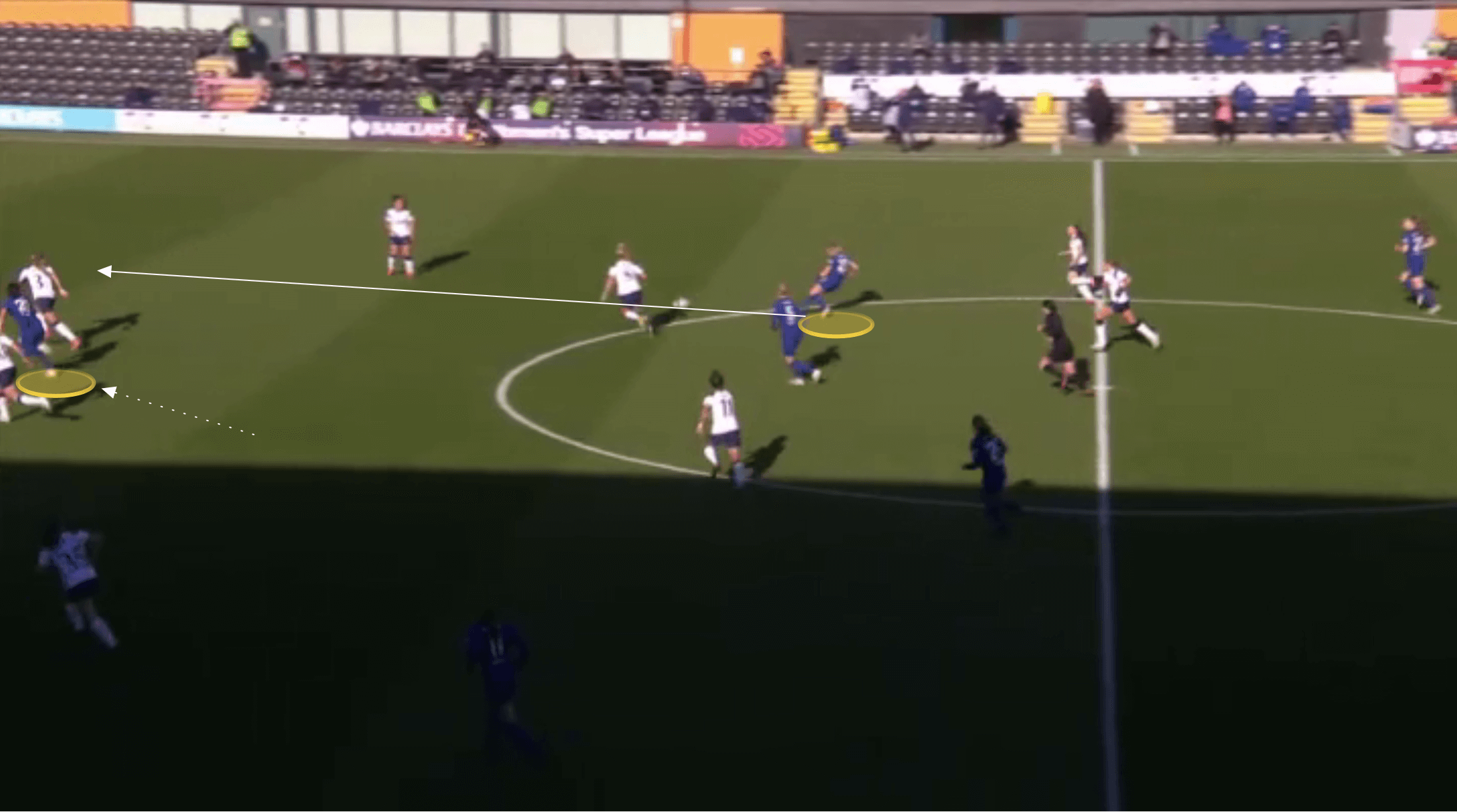
All of this would be useful but not as dangerous if Kerr weren’t the clinical finisher she is.
Since joining the Blues, she has played 26 times and scored 22 goals.
Kerr doesn’t always take that high starting position, and she will either get more compact with her midfield during the defensive phase or look to move deep rather than run in behind to provide a short passing option.
This is most frequently seen when Chelsea’s midfield wins possession in a more congested area, and Kerr is wise to this.
She will drop deep to give an extra passing option if the ball-winner is surrounded by defenders who are potentially counter-pressing.
Kerr can play off of one touch, quickly finding a nearby teammate and spinning off herself to provide a forward pass option again once the ball is with a teammate in space.
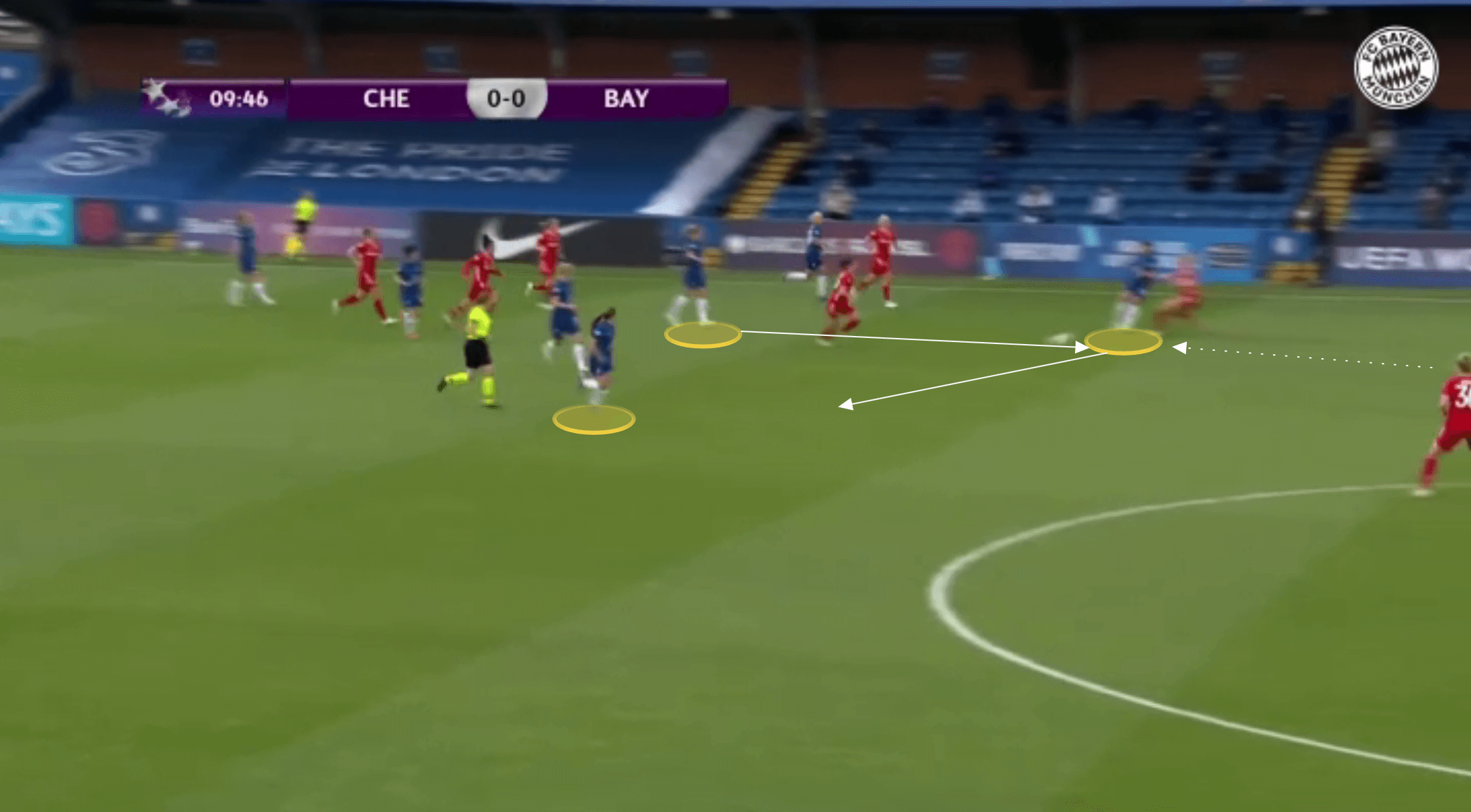
Emma Hayes In possession
Chelsea are used to enjoying large swaths of possession.
They will initially show patience, circling the ball and allowing their midfielders, full-backs, and attackers to get into advantageous positions to structure passing patterns.
The right-back may be used in a more reserved position than her left-back counterpart, who will often push forward into a traditional left-winger position.
This subsequently gives Chelsea a back three which they allow to spread very wide.
This could potentially cause issues with a loss of possession at the back, but Millie Bright and Magdelena Eriksson are outstanding ball-players and this back three stretches the opposition press and leaves plenty of space for Chelsea to overload the centre of the pitch.
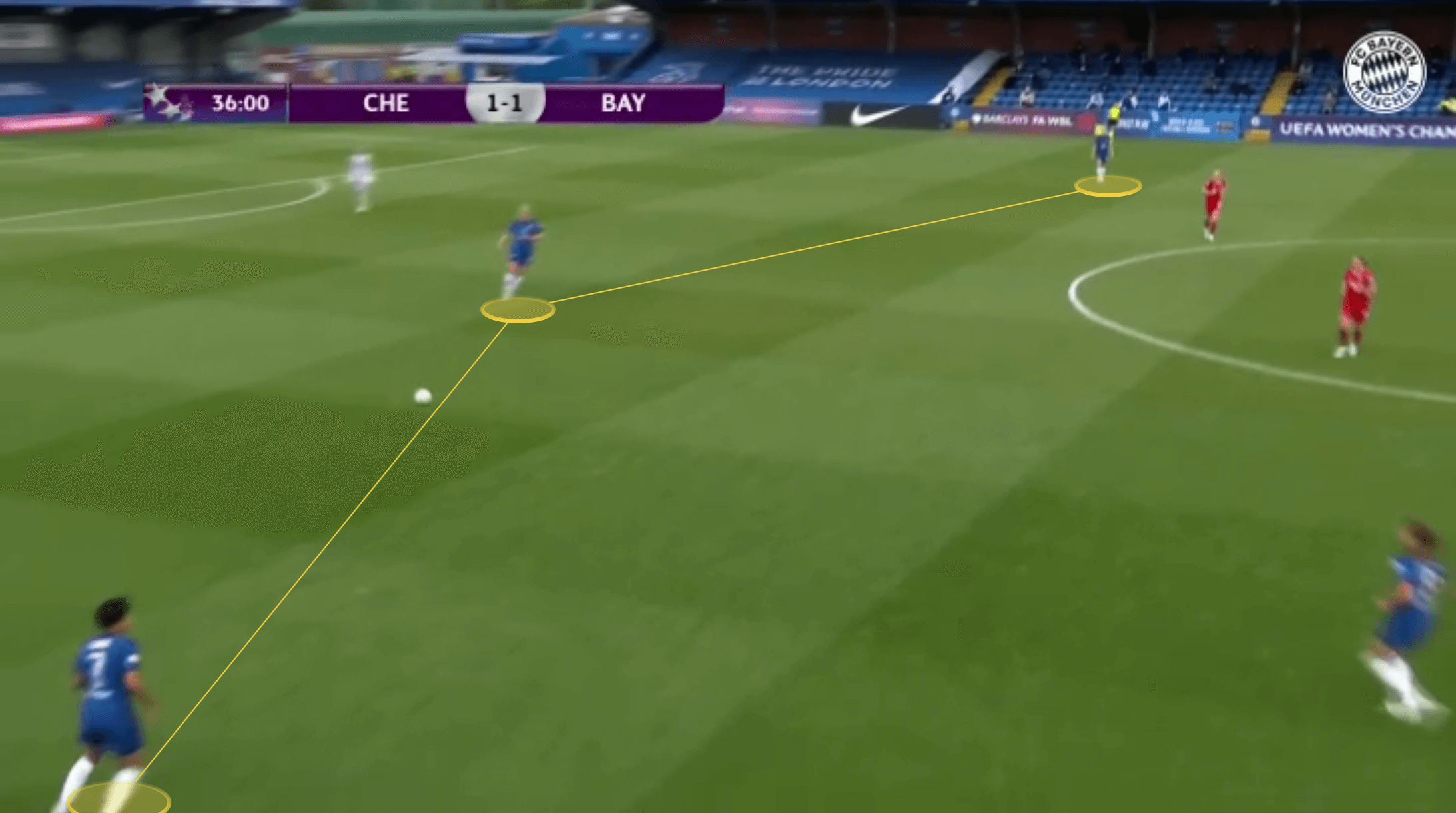
Chelsea’s starting shape is relatively unimportant.
Even if it’s a 4-4-2, they may still use a winger to invert and provide a central three, particularly if the left-back pushes forward to provide width on that flank.
More problematic is given the freedom to roam and she provides quality across the pitch.
Whichever player operates in the pivot, usually Ingle may well draw the attention of opposition midfielders when dropping deep to get on the ball.
One of the other midfielders may well provide an option in between the lines, but Harder is perhaps most effective in doing so, starting from a high starting position and dropping deep to receive, often unmarked.
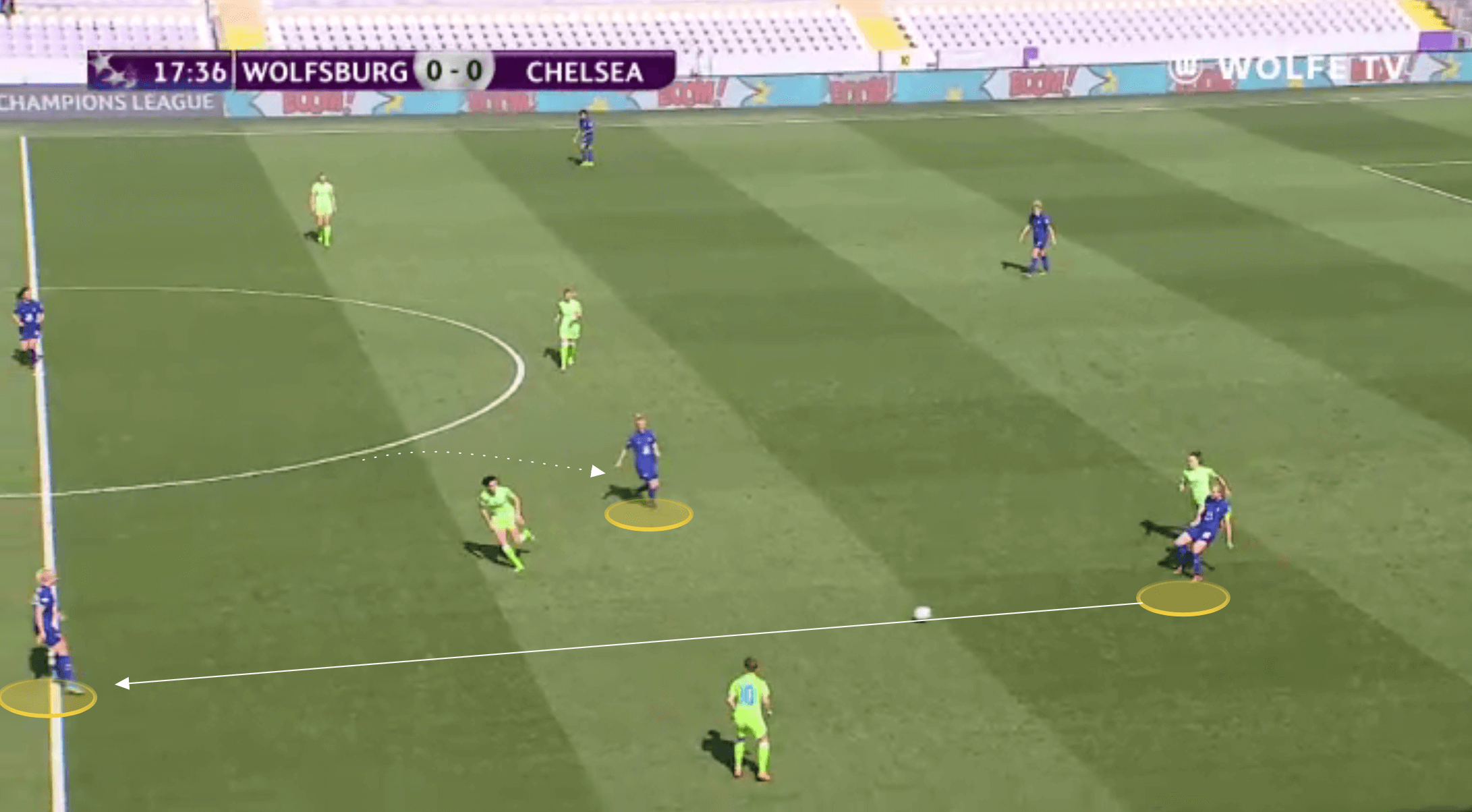
Kerr may drop in, too.
Chelsea’s midfielders operate on a defined stagger, creating space for Kerr to drop into the 10 space and have immediate passing options on either side of her as she comes into possession.
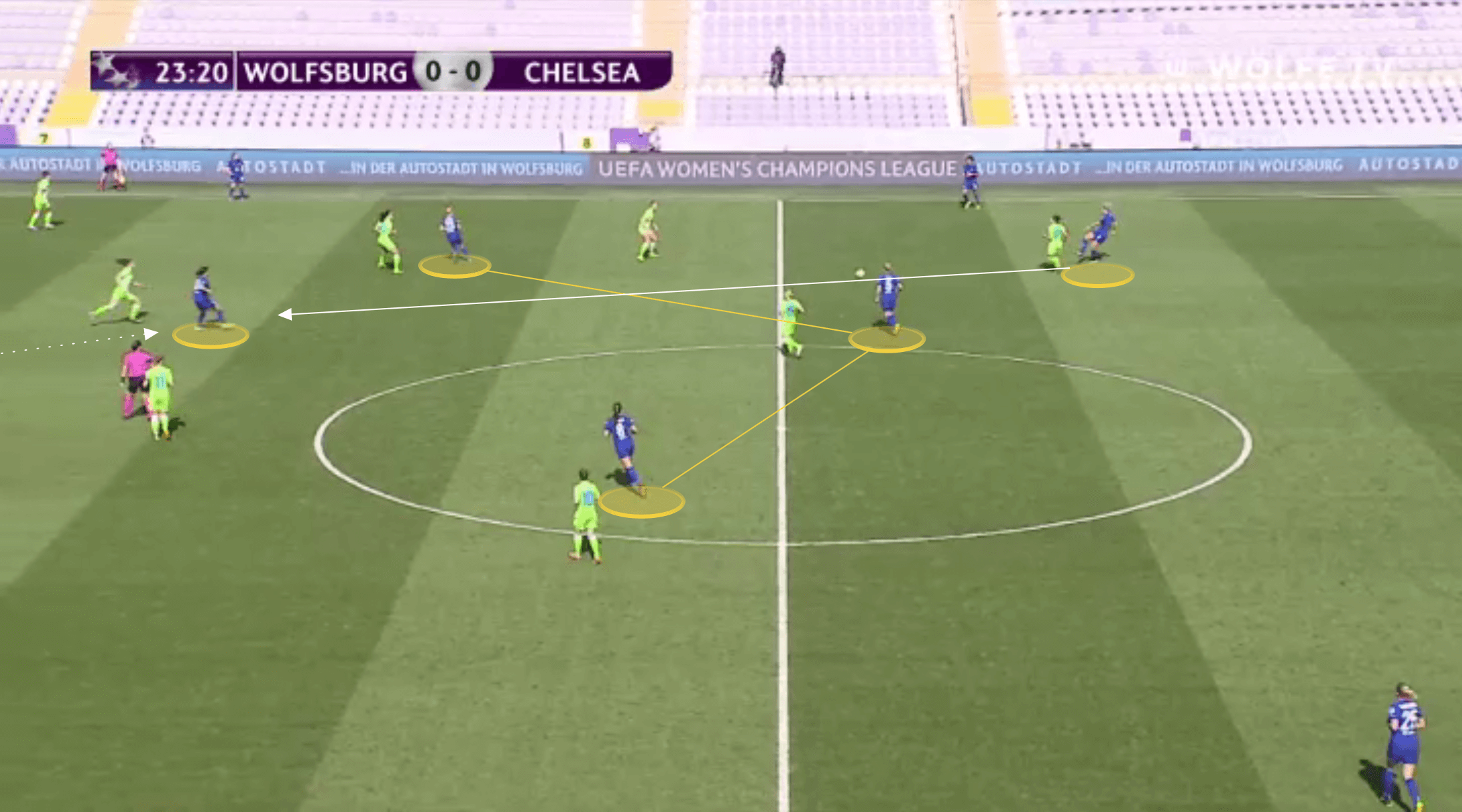
The left-back can push far forward on their flank due to the shape of Chelsea’s midfield three.
The role is interchangeable in terms of personnel, but one of the three will drop the deepest and will often be found in the left half-space in the build-up.
We can see this in the following image.
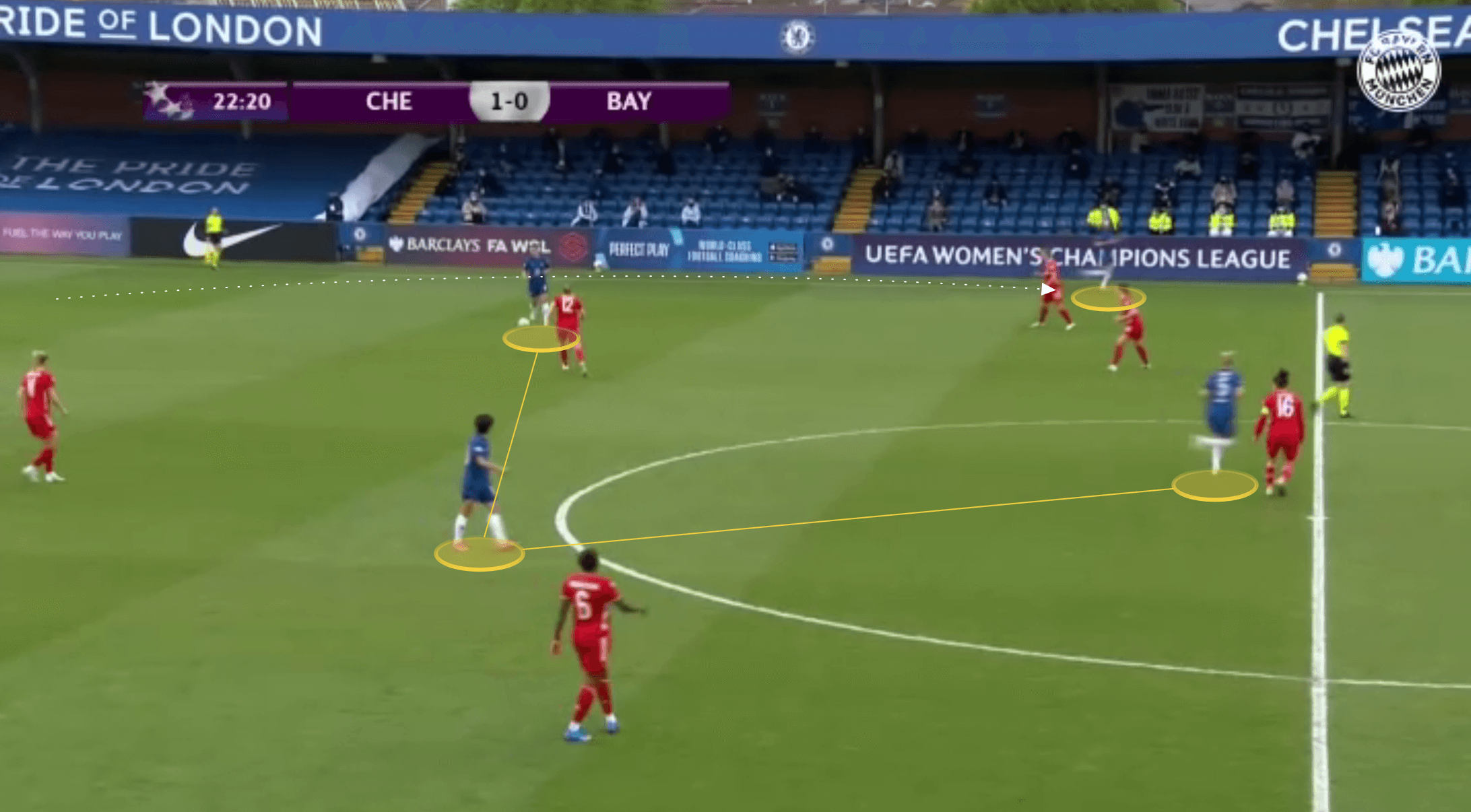
As a result, the left back pushes up, and the remaining two midfielders continuously provide that midfield stagger, or “play sign,” as some may know it.
This is more commonly seen against a high press, where Chelsea don’t operate with that back three as highlighted earlier due to the increased threat of a direct, central counter-attack if possession is lost during build-up play.
Passing patterns are created from the fluid shape Chelsea take in possession.
Simple up, back, and through pass combinations can be devastating and are easily played with sequences of one-touch passes, given the midfield’s close proximity to the front line and the fullbacks.
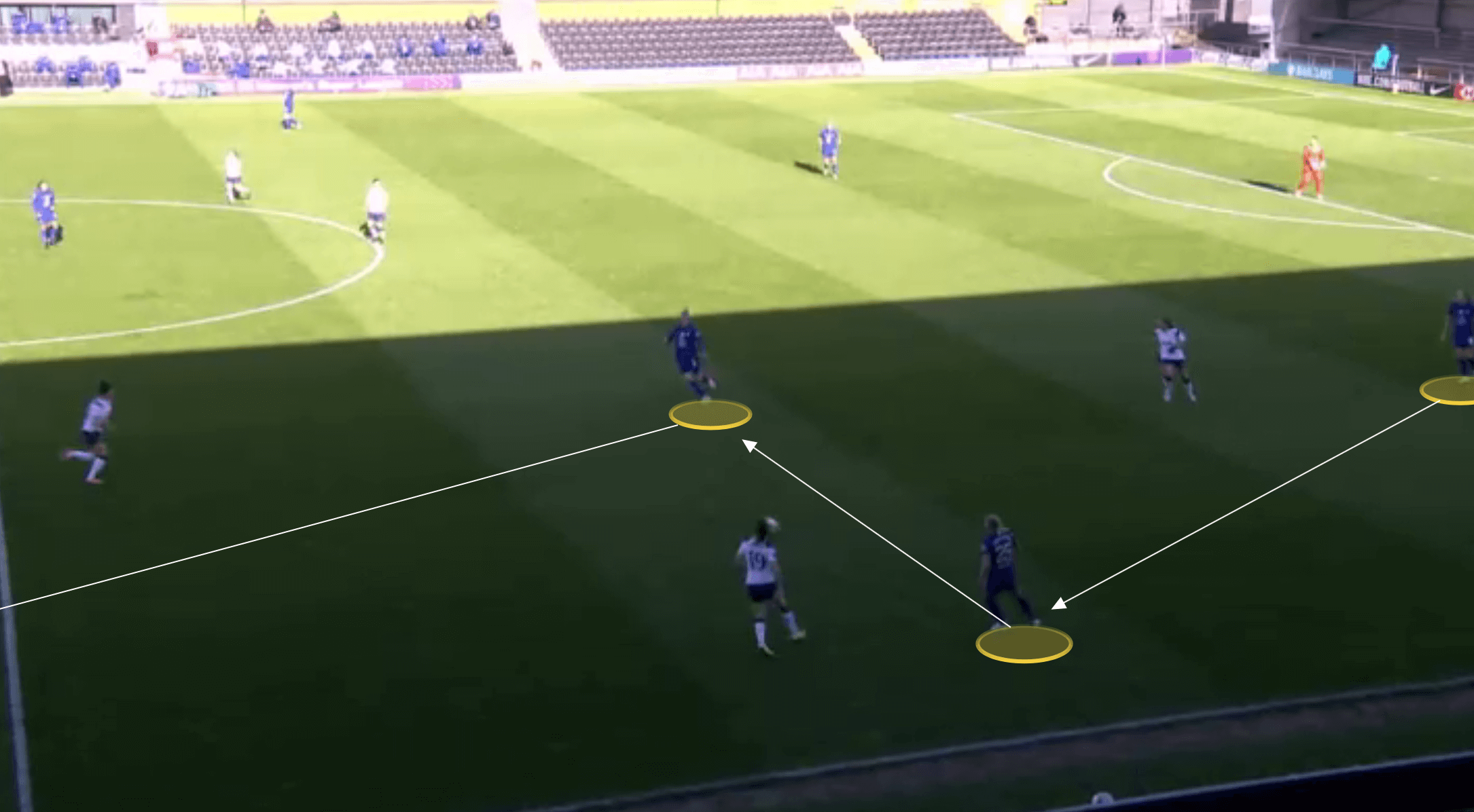
The pass combination shown over the past image and the following one shows the pass breaking the lines and getting the ball into Sam Kerr, who has dropped into a less conventional wider position.
The left-back inverts and underlaps Kerr before releasing Kirby in behind.
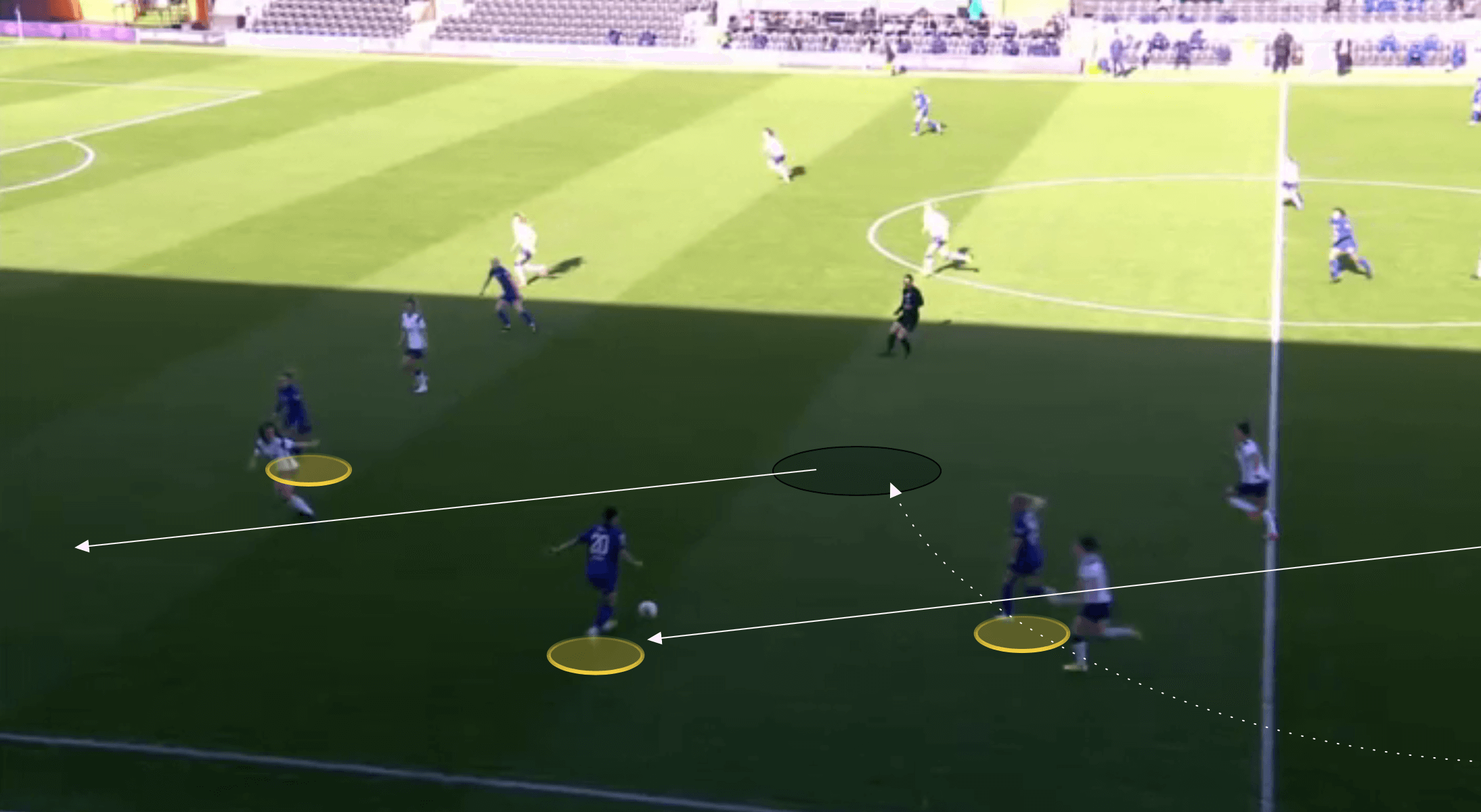
As we saw in the transitions section of this analysis, Kerr and Kirby are two players who excel at using space to run behind and attack.
Whilst Kerr will drop off herself at times, again, as we’ve seen, Harder consistently does this, regularly finding space between the lines of the opposition defence and midfield.
If she can receive in a central position, like in the following image, it provides space for a straight-through pass into the space behind, with Kerr ready to loop her run to remain onside and latch onto this pass.
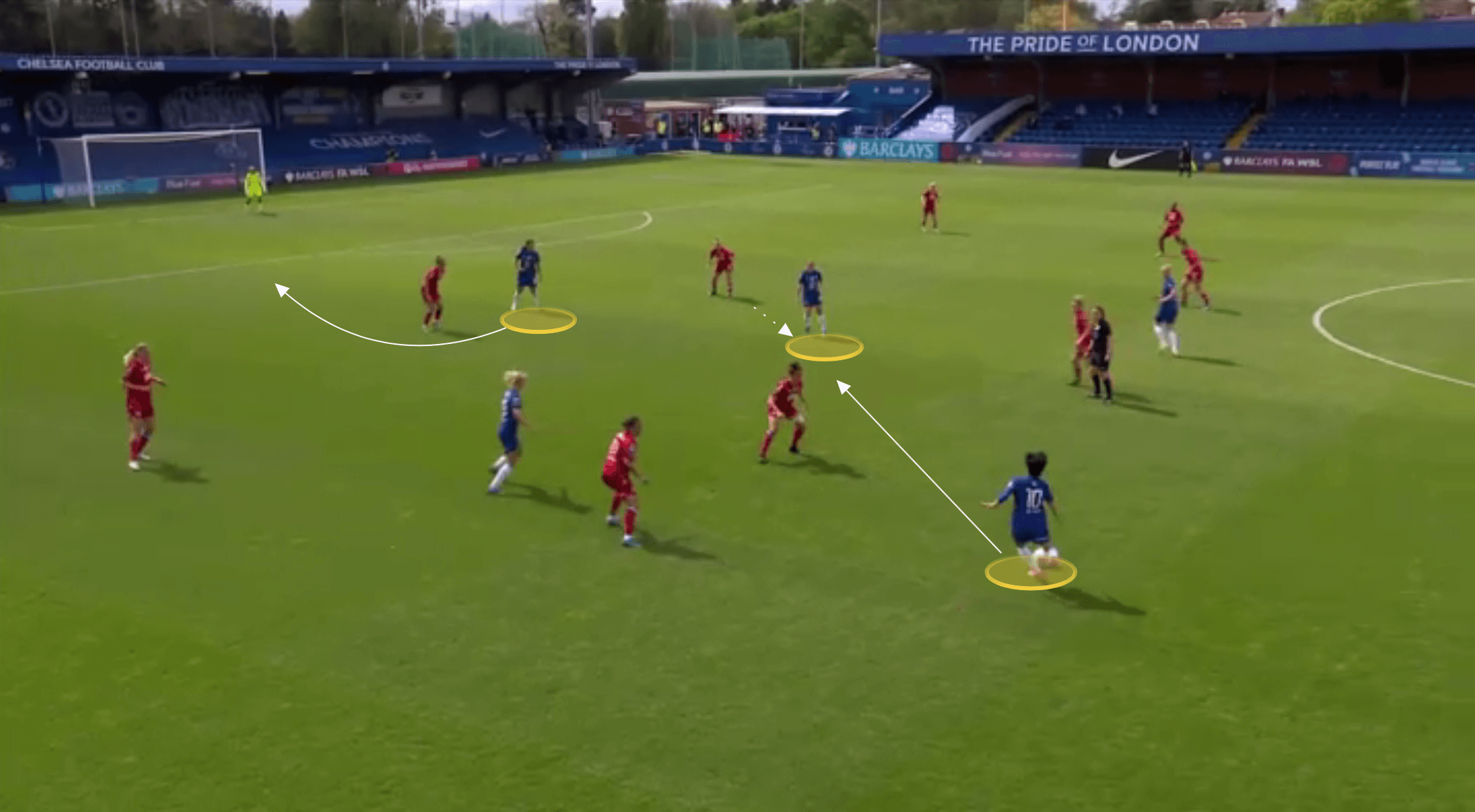
Out of possession
Hayes has instilled an effective pressing and defensive structure into her Chelsea side, which makes them a highly organised defensive outfit and incredibly difficult to break down.
If they choose to press with a front three, Kerr will initially lead the line, with Kirby and Harder in support.
Note how Kerr is pressing to keep the Wolfsburg pivot in her cover shadow in the following image, while Harder tucks inside, ready to cover this player still regardless.
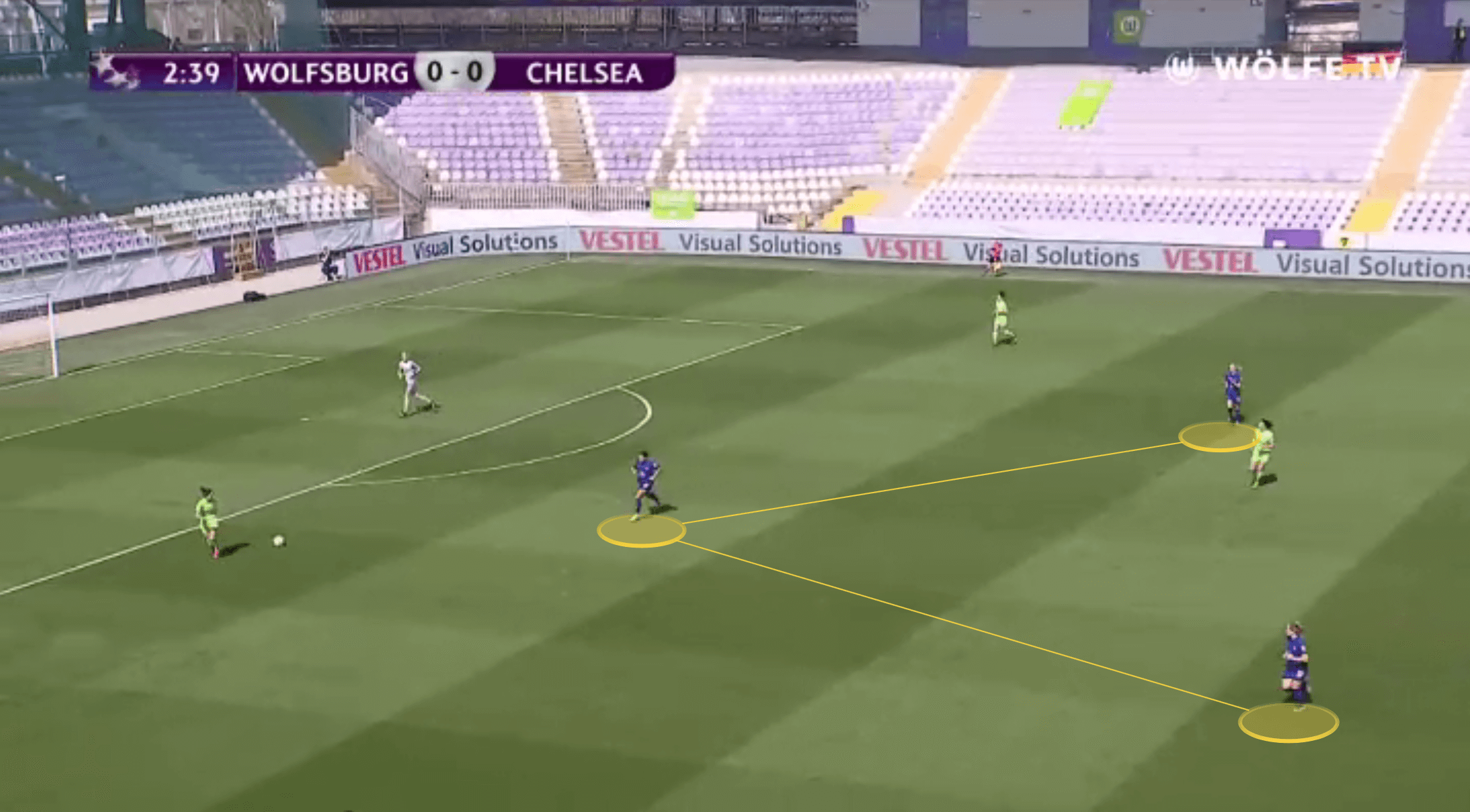
If the ball is circled to the other side, then Kirby may tuck inside in this instant, with Harder shifting across to prevent the forward pass in the half-space, just as Kirby does in the previous image.
If the ball is worked wide, then Kerr will close the space and prevent the inside pass, while Harder comes well inside, not worried about leaving the opposite flank wide open.
This ensures that the highlighted pivot in the following image can’t impact the phase of play in any way.
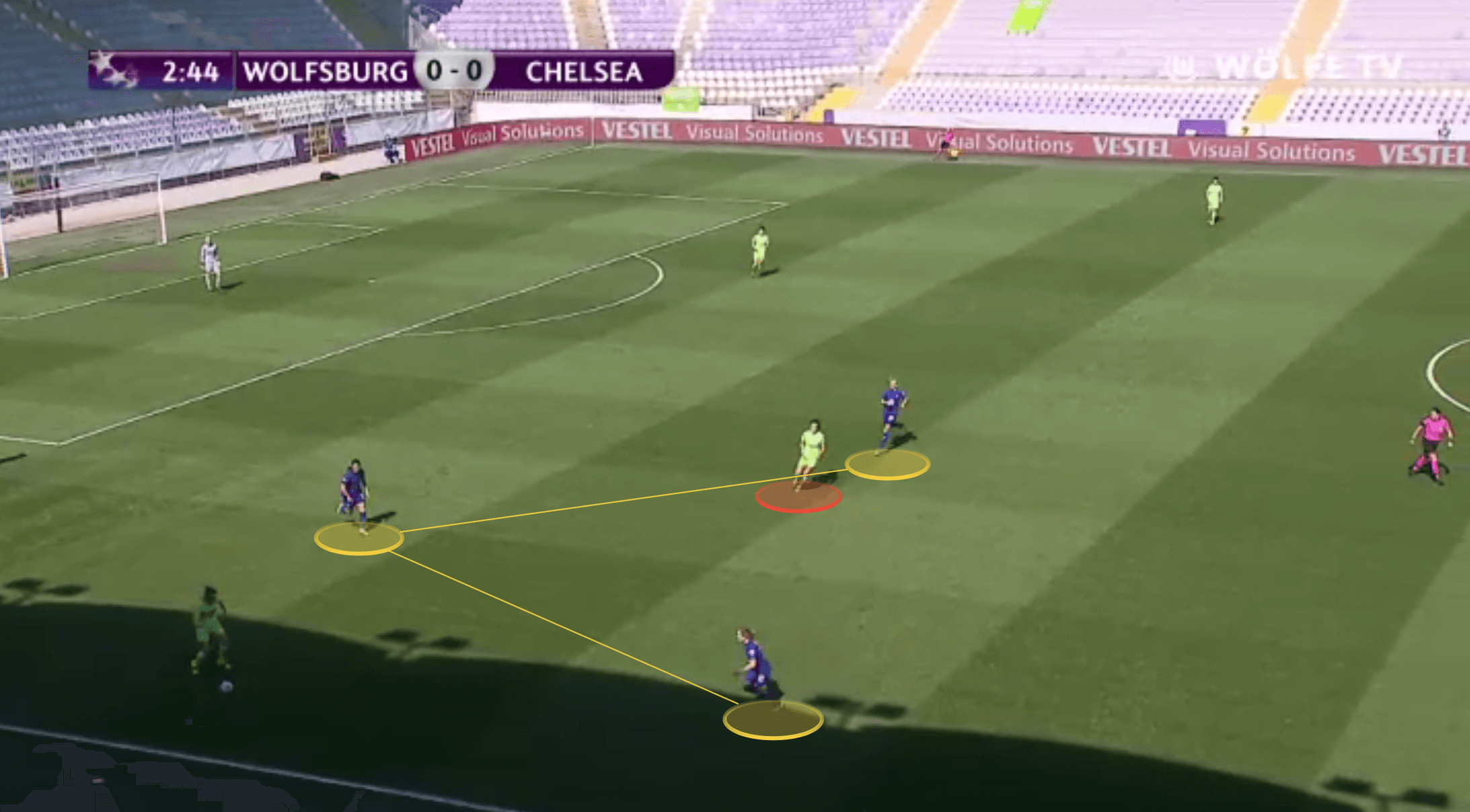
This shape may well remain beyond that initial press, with Chelsea’s front three remaining compact even into their own half.
The pivot continues to remain covered, and Chelsea’s front three creates a 3v3 with the opposition centre-back, full-back and pivot.
As the opponent works the ball backwards, as in this image, Chelsea’s midfield is quick to push up and prevent any kind of space from being created between the lines.
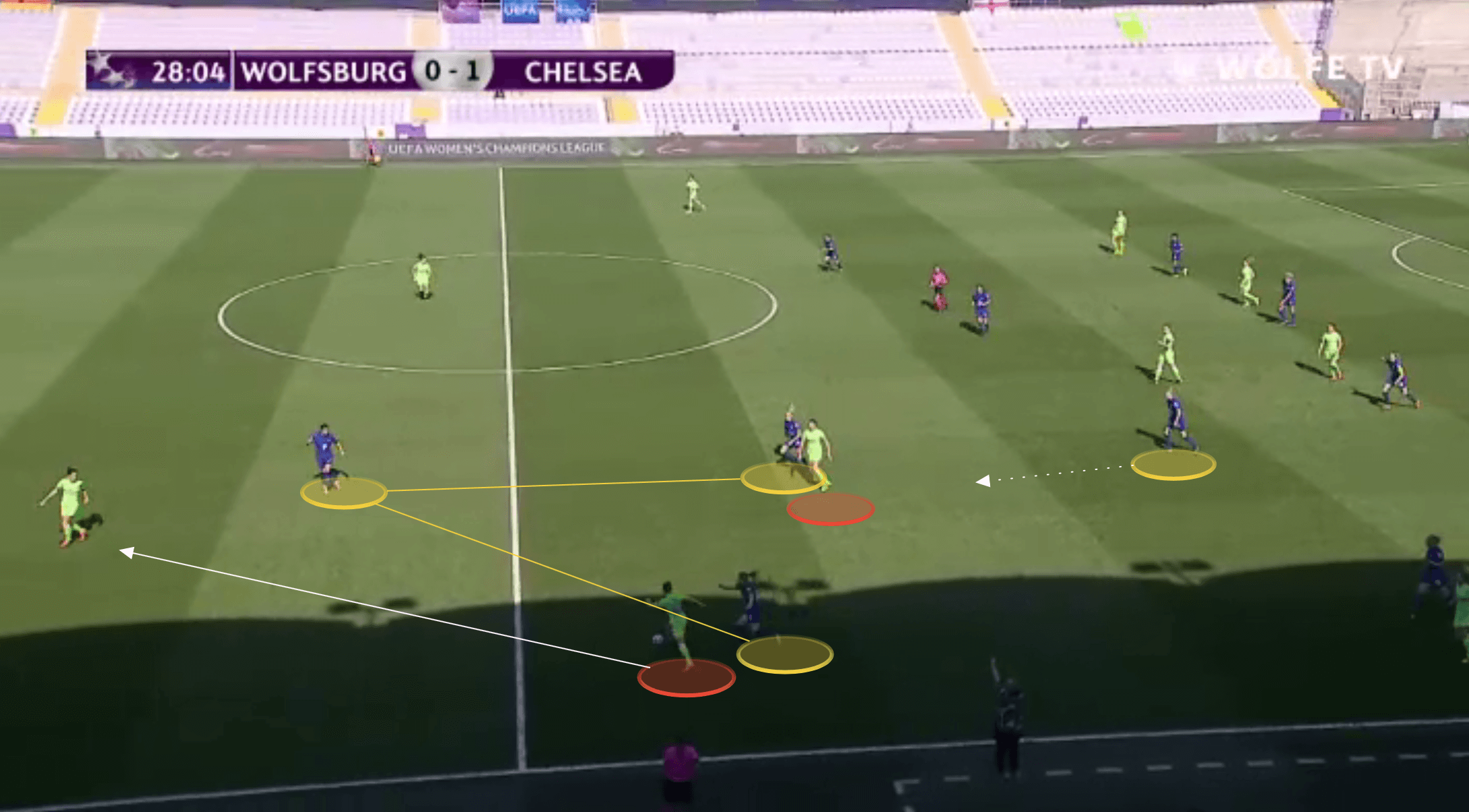
We can see this below as Wolfsburg aim to use the space created by the backward pass to release their pivot finally.
However, Ingle is wise to this and is already well in the act of applying pressure as the pivot receives it.
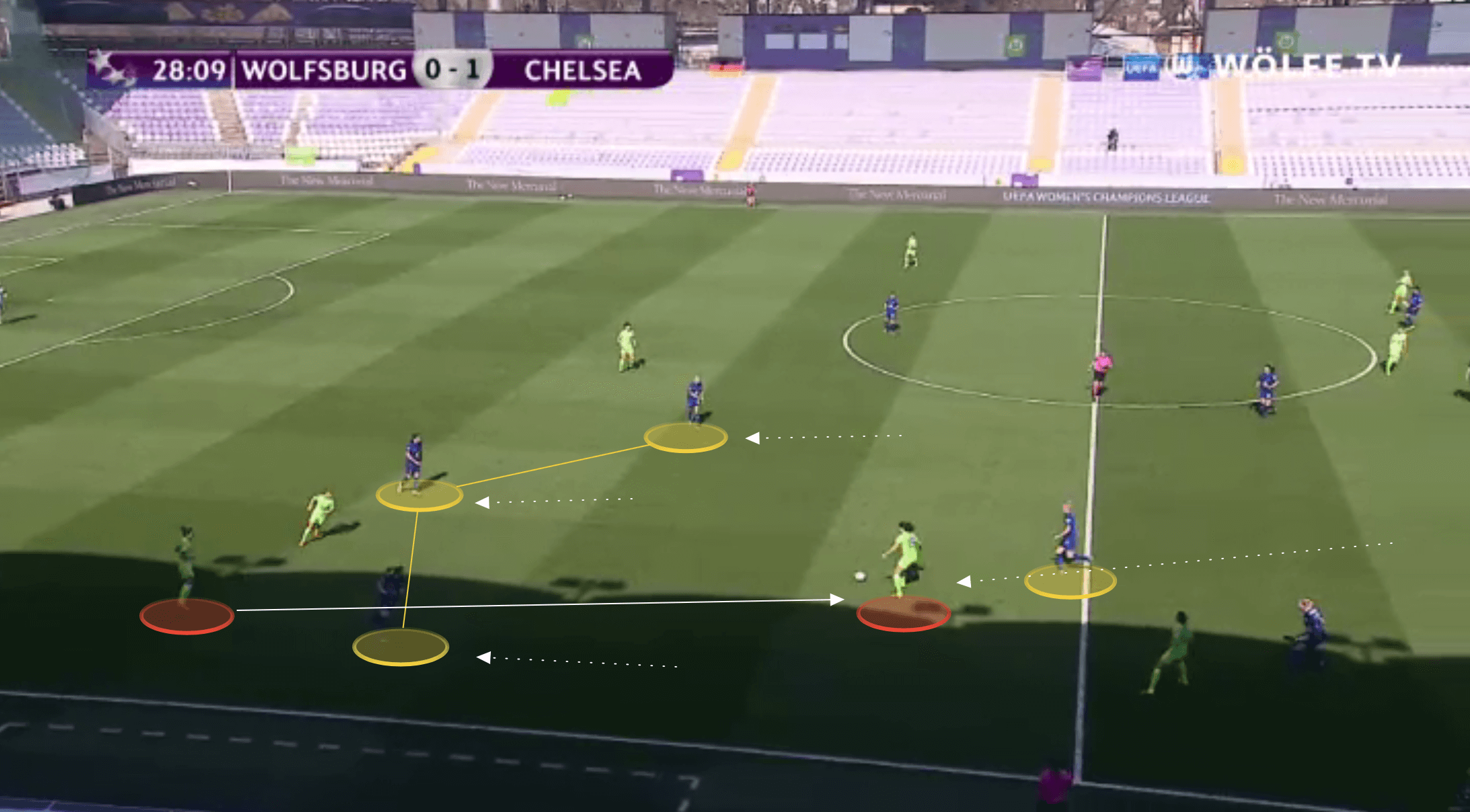
Chelsea’s defensive shape beyond this initial pressing shape is compact both vertically and horizontally.
In this example, Kirby is part of the front three, but with a midfield four, she will drop deeper, and Chelsea may press with a 4-4-2 shape.
However, the compactness remains the same.
There is a slight stagger to the forward and midfield lines, but generally, they remain quite flat.
Because of their compactness, they continuously operate with little space between the lines for opponents to move into to receive and realistically receive a line-breaking pass.
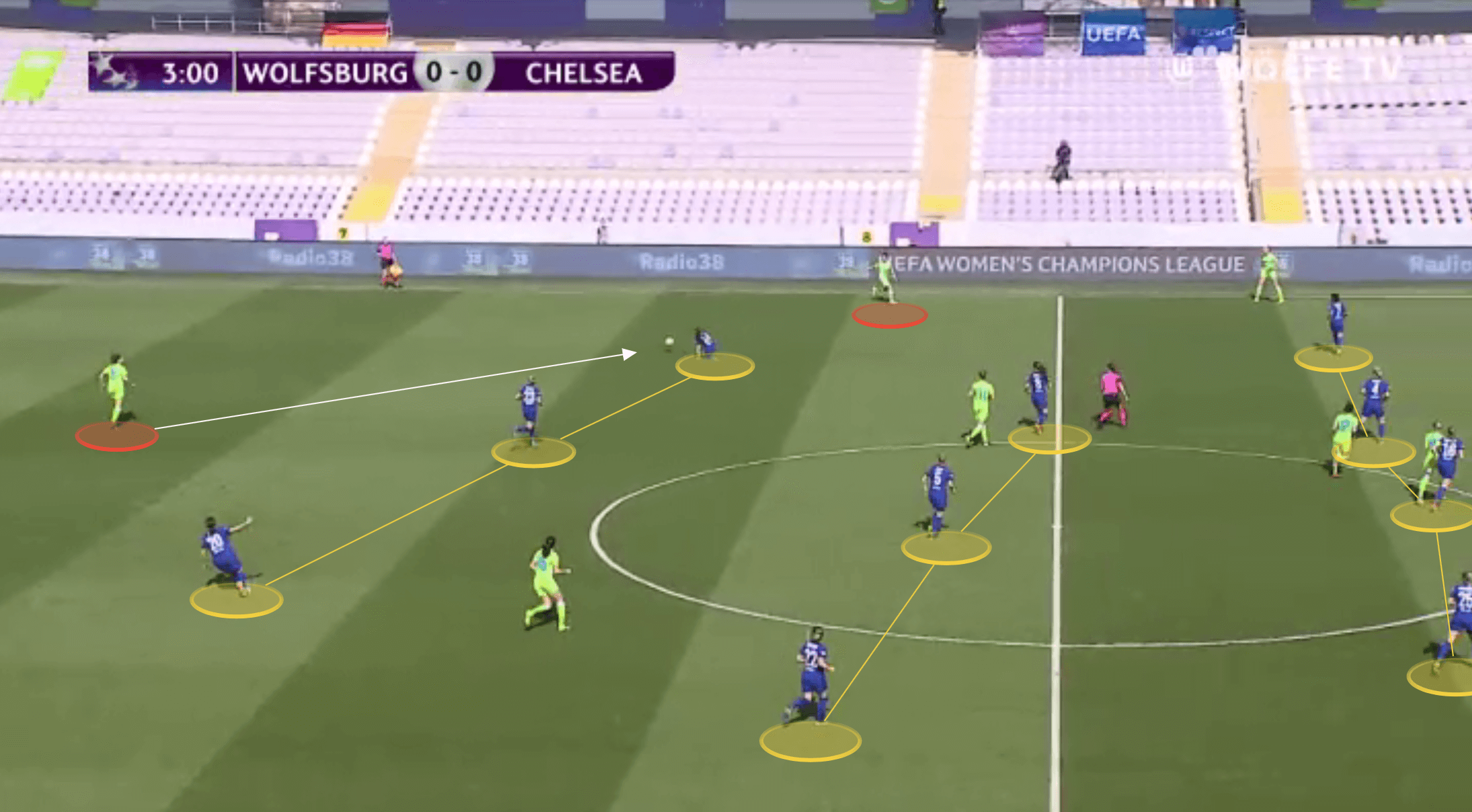
Conclusion
Whilst the other teams around Chelsea in the FAWSL continue to strengthen at an alarming rate, Hayes has created a winning formula with the Blues.
Based around quick, direct attacking players anchored by defensively intelligent and highly competent ball players, she has forged a side that is highly dangerous in possession and can move the ball forward into devastating attacks in the blink of an eye.
As such, they are incredibly effective in attacking transition.
It isn’t just their potent attacking force that makes them so difficult to play against.
Their impressively regimented pressing structure and defensive shape also make it difficult for any side looking to break them down with the ball themselves.




Comments